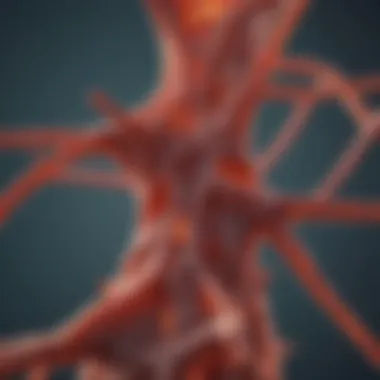Understanding AP2 Antibody: Structure and Clinical Impact


Overview of Research Topic
Brief Background and Context
The AP2 antibody plays a crucial role in immunology. This antibody targets specific protein structures, thus influencing various immune responses. Understanding its structure and function provides significant insight into both normal physiology and pathological conditions. Historically, antibodies have been a focal point in research, leading to advances in vaccines and therapies. The AP2 antibody is notable for its unique binding mechanisms and specificity, making it a subject of interest for scientists and clinicians alike.
Importance in Current Scientific Landscape
In today's scientific environment, the relevance of AP2 antibodies extends beyond fundamental immunology. They are investigated in numerous diseases, including autoimmune disorders and cancers. Increased understanding of AP2 can lead to the development of targeted therapies, improving patient outcomes. Moreover, the exploration of this antibody aligns with broader trends in precision medicine, where personalized treatment approaches are tailored to individual patient profiles.
Understanding the structure and function of AP2 antibodies could unlock new therapeutic possibilities in modern medicine.
Methodology
Research Design and Approach
A comprehensive review of the literature offers a systematic approach to understanding AP2 antibodies. Both qualitative and quantitative studies contribute to the body of knowledge. This entails evaluating research articles, clinical trial results, and observational studies that focus on AP2 antibodies' role in human health.
Data Collection Techniques
Data collection involved various techniques:
- Literature Review: An extensive review of published papers in journals focused on immunology.
- Meta-Analysis: When applicable, meta-analyses have been included to synthesize findings across multiple studies.
- Case Studies: Specific case studies illustrating the use of AP2 antibodies in clinical practice also provide practical insights.
This combination of methodologies ensures a well-rounded understanding of AP2 antibodies, fostering an informed perspective on their clinical implications.
Prelims to AP2 Antibody
The AP2 antibody plays a crucial role in immunology and molecular biology, making it an essential subject of study. Understanding its structure and function can shed light on broader immune response mechanisms and potential therapeutic applications. In this section, we will discuss the foundational aspects of the AP2 antibody, which prepares readers for deeper insights into its biological significance and potential clinical implications.
Definition of AP2 Antibody
The AP2 antibody is classified as a type of immunoglobulin produced by the immune system, specifically involved in recognizing and binding to particular antigens. These antibodies are sophisticated proteins, featuring unique binding sites that allow them to interact with target molecules in a highly specific manner. This characteristic specificity is generally due to the variable regions of the antibody which determine its affinity for particular antigens. The AP2 antibody often emerges in research focusing on immune responses to various pathogens or diseases, highlighting its relevance in understanding both normal and pathological conditions.
Historical Background
The study of AP2 antibodies has evolved significantly since their identification. Initially, research surrounding these antibodies began primarily as a means to explore immune responses in basic animal models. The specific actions and interactions of the AP2 antibodies were observed in various conditions, paving the way for advancements in diagnostics and treatment strategies.
Over the decades, foundational studies highlighted how AP2 antibodies could be utilized in laboratory settings, contributing to innovations in immunotherapy and vaccine development. The increasing understanding of AP2 antibodies facilitates advancements in their applications, thus generating ongoing research interest and clinical exploration.
As we delve deeper into the molecular structure, production methods, and clinical implications of AP2 antibodies in the following sections, it becomes evident that a thorough understanding of their role is essential for both practitioners and researchers in the field.
Molecular Structure of AP2 Antibody
The molecular structure of the AP2 antibody plays a crucial role in its functionality and effectiveness within the immune response. Understanding this structure not only aids in elucidating how these antibodies interact with antigens but also highlights their significance in clinical applications. The specifics of the molecular architecture are fundamental to appreciating how alterations in structure can influence antibody performance, diagnostic capabilities, and therapeutic outcomes.
Basic Components
AP2 antibodies, like many other antibodies, consist of various structural components that shape their function. An antibody broadly comprises two heavy chains and two light chains, which create a Y-shaped molecule. These components are joined together by disulfide bonds, forming the overall structure that is critical for its ability to bind specific antigens.
- Heavy Chains: The heavy chains provide the primary framework of the antibody. The variability in the constant region of these chains defines the antibody's class, while the variable region plays a key role in recognizing specific antigens.
- Light Chains: Similar to the heavy chains, the light chains come in two types: kappa and lambda. Their structure contributes to the specificity and stability of the antigen-binding site.
- Fab and Fc Regions: The antibody can be divided into two functional regions: the Fab (fragment antigen-binding) region, which binds to the target antigen, and the Fc (fragment crystallizable) region, which mediates interactions with other components of the immune system.


The combination of these basic components determines the unique characteristics of AP2 antibodies, influencing their interactions in a biological context.
Detailed Structural Analysis
Diving deeper into the molecular structure of AP2 antibodies reveals intricate details that are pivotal for their functionality. The precise arrangements of amino acids within the variable regions of both heavy and light chains create unique antigen-binding sites.
The specificity of an antibody for its antigen is primarily determined by the shape and charge of this binding site. Structural analysis often employs techniques like X-ray crystallography and nuclear magnetic resonance (NMR) spectroscopy to visualize and confirm the spatial arrangement of atoms within the antibody.
Moreover, the glycosylation patterns on the Fc region can significantly influence the antibody's stability, half-life, and interaction with Fc receptors on immune cells. These modifications can affect how the antibody operates within the body, providing avenues for therapeutic enhancement or alterations.
Understanding the detailed structure of AP2 antibodies enables researchers to engineer modifications that can enhance their effectiveness in clinical settings.
In summary, the molecular structure of AP2 antibody is not simply a matter of composition but an elaborate arrangement that underpins its biological functions. Grasping the significance of these components and their interaction provides invaluable insights into the broader implications of AP2 antibodies in immune response and clinical applications.
Production of AP2 Antibody
The production of AP2 antibody is essential for understanding its various roles in both research and clinical applications. This section investigates how AP2 antibodies are generated in biological systems and through recombinant methods. It is crucial to explore these processes, as they directly impact the availability, quality, and effectiveness of antibodies for diverse uses including diagnostics and therapeutics.
Biological Production in Organisms
AP2 antibodies can be naturally produced by the immune system of organisms. When an antigen enters the body, B cells recognize it and respond by undergoing a process called clonal selection. This process results in the proliferation of specific B cells that can produce antibodies tailored to that antigen.
The production in organisms occurs via several steps:
- Antigen Recognition: Immune cells (B cells) identify and bind to the specific antigen being targeted.
- Clonal Expansion: The selected B cells rapidly multiply to create a large population of cells focused on producing the same antibody.
- Differentiation: Some of these B cells evolve into plasma cells, which are specialized for high output of antibodies.
Naturally produced AP2 antibodies have the advantage of being optimized by evolution to effectively bind to target antigens, which can be crucial for therapeutic and diagnostic processes. However, this method depends on the organism's ability to mount a sufficient immune response, which can vary significantly across species and individual immune health.
Recombinant Production Techniques
Advancements in biotechnology have led to the development of recombinant production methods for AP2 antibodies. This involves manipulating genetic material to produce antibodies in laboratory settings, often using bacteria, yeast, or mammalian cells as hosts. Recombinant techniques allow for the large-scale production of monoclonal antibodies, offering consistency and reliability in their application.
Key steps in recombinant production of AP2 antibodies include:
- Gene Engineering: The genes coding for specific antibody components are cloned and inserted into expression vectors.
- Cell Culture: The modified cells are cultured under controlled conditions, enabling them to produce the desired antibody.
- Purification: Following production, antibodies are extracted and purified to remove cellular debris and ensure they are suitable for research or clinical use.
This method also allows for various modifications such as glycosylation changes, which can enhance the efficacy of the antibodies or reduce immunogenicity. Additionally, recombinant production can be adapted for high-throughput settings to meet the demands of both research and commercial needs.
Function of AP2 Antibody in Immune Response
The function of AP2 antibodies in the immune response is a significant area of focus within immunology. These antibodies are instrumental in the body's ability to recognize and fight against pathogens, and their mechanisms contribute to a better understanding of autoimmune diseases and other immune-related conditions. AP2 antibodies can have diverse roles depending on their interactions with target antigens. Their contribution to immune defense is multifaceted and critical in both research and clinical settings.
Mechanisms of Action
AP2 antibodies operate primarily through several mechanisms that enhance the immune response:
- Antigen Recognition: These antibodies bind specifically to certain antigens, leading to the activation of immune cells. This recognition triggers effector mechanisms that contribute to pathogen neutralization.
- Complement Activation: Upon binding to an antigen, AP2 antibodies can activate the complement system. This sequence of events leads to opsonization of pathogens, making them more recognizable to phagocytes.
- Cellular Activation: The engagement of AP2 antibodies with their target antigens can stimulate different types of immune cells. For instance, B cells may be prompted to produce more antibodies, whereas T cells can be activated to aid in directly combating infections or tumors.
"Understanding the mechanisms through which AP2 antibodies operate is essential for developing effective therapeutic strategies."
- Neutralization of Toxins or Viruses: AP2 antibodies can also directly neutralize toxins or neutralize viruses. This results in a decreased ability of pathogens to infect host cells.


The diversity in these mechanisms highlights the importance of AP2 antibodies in shaping an effective immune response.
Target Antigens
The target antigens for AP2 antibodies can vary based on the specific immune challenge. This variability can include:
- Pathogen-Associated Proteins: Antigens derived from viruses or bacteria that are recognized by AP2 antibodies. This is critical for addressing infections.
- Autoantigens: In cases of autoimmune diseases, AP2 antibodies may mistakenly target the body’s own proteins, leading to damaging immune reactions.
- Tumor Antigens: AP2 antibodies are explored in cancer therapies for their ability to recognize and bind to unique antigens expressed on tumor cells, facilitating targeted immune responses.
The ability of AP2 antibodies to recognize a broad range of antigens illustrates their significant role in both normal immune functions and in pathological conditions. Understanding these interactions can pave the way for new diagnostic and therapeutic strategies in clinical practice.
Clinical Significance of AP2 Antibody
The AP2 antibody holds substantial importance in modern clinical practices and scientific research. Understanding its clinical significance sheds light on how these antibodies can contribute to diagnosing and treating diseases effectively.
Role in Disease Pathogenesis
AP2 antibodies are implicated in various diseases, influencing both the progression and development of pathologies. For instance, these antibodies can interact with specific antigens found in autoimmune diseases, triggering inappropriate immune responses. Understanding the role of AP2 antibodies in these scenarios can help in identifying the underlying mechanisms of various conditions. Researchers have noted that elevated levels of AP2 antibodies are often found in patients with specific autoimmune disorders such as lupus and rheumatoid arthritis. This correlation suggests a potential biomarker role for AP2 antibodies, aiding physicians in diagnosing these diseases. Additionally, chronic inflammation caused by these antibodies can lead to tissue damage, further complicating patient management.
Diagnostic Applications
The unique characteristics of AP2 antibodies make them valuable in the diagnostic field. Their presence can help in identifying specific autoimmune conditions. For example, diagnostic tests measuring AP2 antibody levels are becoming important tools in clinical laboratories. By comparing these levels with known benchmarks, healthcare professionals can diagnose conditions more accurately. This aspect is crucial, as earlier and more accurate diagnosis can significantly impact treatment outcomes. Moreover, as the understanding of these antibodies grows, novel assays and testing methodologies are being developed. These innovations may very well enhance diagnostic capabilities.
Therapeutic Potential
In recent years, there has been increasing interest in the therapeutic applications of AP2 antibodies. Researchers are exploring ways to leverage these antibodies for targeted treatments in autoimmune diseases. Some studies suggest that modulating the activity of AP2 antibodies could lead to better management of disease symptoms and progression. Furthermore, the development of monoclonal antibodies based on AP2 specificity may open new avenues for treatment. By targeting specific pathways influenced by AP2 antibodies, it could be possible to design more effective therapies. However, while the potential is promising, further research is essential to evaluate the efficacy and safety of these treatments in diverse patient populations.
The growing understanding of AP2 antibody dynamics offers substantial potential for advancements in diagnostics and targeted therapeutics.
Research and Innovations Involving AP2 Antibody
The study of AP2 antibodies has significantly evolved over recent years. This section highlights key innovations and research findings that shape our understanding of these antibodies. These advances impact both basic science and clinical applications. The exploration of AP2 antibodies helps in understanding immune responses, thus enabling better therapeutic strategies for various diseases.
Recent Studies
Recent investigations have provided critical insights into the role of AP2 antibodies in immune modulation. For example, studies published in reputable journals demonstrate the potential of AP2 antibodies in targeting specific antigens linked to autoimmune disorders. Researchers are focusing on identifying precise mechanisms by which AP2 antibodies engage with the immune system.
- Antigen Specificity: Recent work suggests that AP2 antibodies can discriminate between closely related antigens, improving diagnostic accuracy.
- Therapeutic Applications: Research indicates promising results where AP2 antibodies could enhance therapeutic outcomes in patients with chronic diseases, such as rheumatoid arthritis.
- Innovative Technologies: Innovations like CRISPR technology are being utilized to create more specific AP2 antibodies, furthering their research potential.
The advances in this field are not solely theoretical; applied research into AP2 antibodies is regularly yielding practical outcomes. These studies facilitate collaborations among academics, clinicians, and biotechnology firms, enhancing the innovation pipeline.
Future Directions in Research
The future of AP2 antibody research is full of potential. Understanding their role in immune functions and pathological conditions paves the way for novel therapeutic strategies. Several key avenues deserve attention:
- Mechanistic Studies: Delving deeper into the interactome of AP2 antibodies with other immune cells can grant insights into their modulation abilities.
- Clinical Trials: Future research should focus on longitudinal studies that assess the efficacy and safety of therapies incorporating AP2 antibodies, particularly for treating diseases such as cancer and autoimmune disorders.
- Personalized Medicine: A tailored approach that analyzes individual patients' responses to therapies using AP2 antibodies could revolutionize treatment protocols.
- Integration of Artificial Intelligence: The use of AI in analyzing data related to AP2 antibodies may expedite research findings and enhance precision medicine efforts.
"Research involving AP2 antibodies is not just about finding answers. It is about redefining treatment paradigms and improving patient outcomes."
Challenges in the Study of AP2 Antibody
The study of the AP2 antibody is significant, as it provides deep insights into its structure and functional role in immunology. Nevertheless, several challenges complicate research and applications surrounding AP2 antibodies. Understanding these challenges can facilitate more effective research and therapeutic strategies.


Technical Limitations
Technical limitations present considerable hurdles in the investigation of AP2 antibodies. The production methods for antibodies, whether biological or recombinant, can sometimes lead to variations in quality and activity. For instance, technologies such as monoclonal antibody production can be hindered by inconsistencies in hybridoma cell lines. These discrepancies may affect the affinity and specificity of the antibodies produced, leading to less reliable results in research or clinical settings.
Furthermore, high-throughput screening methods often fail to capture the full range of antibody interactions within a biological system. This limitation can result in an incomplete understanding of the physiological role of AP2 antibodies and their potential interactions with various antigens. It is crucial for researchers to develop standardized protocols to enhance the reproducibility and reliability of their findings.
Biological Variability
Biological variability is another significant challenge when studying AP2 antibodies. The immune response can differ widely among individuals, influenced by factors such as genetics, environment, and health status. These variations lead to different antibody profiles and responses in patients, making it difficult to generalize findings across studies.
Additionally, the presence of diverse isoforms of the AP2 antibody might contribute to variability in its function and efficacy. Understanding these isoforms requires distinct methodologies and detailed characterizations, which can be resource-intensive and time-consuming. Researchers must account for this variability in both laboratory settings and clinical applications, posing a challenge in developing universally effective diagnostics and treatments.
"The challenges in the study of the AP2 antibody highlight the need for robust methodologies that can withstand biological complexities."
In summary, addressing technical limitations and biological variability is essential for advancing the scientific understanding of AP2 antibodies. This awareness leads to improved accuracy in research outcomes and greater efficacy in potential therapeutic interventions. By fostering innovation and rigorous methodologies, the future study of AP2 antibodies can yield more reliable and clinically relevant results.
Ethical Considerations in AP2 Antibody Research
Ethics in scientific research is crucial for ensuring integrity, safety, and public trust. In the context of AP2 antibody research, ethical considerations play a vital role in guiding methodologies, protecting subjects, and promoting responsible practices. As the field of immunology advances, understanding these ethical frameworks expands not only the scientific legitimacy of research but also its societal acceptance.
Several specific elements highlight the importance of ethical considerations in research involving AP2 antibodies:
- Animal Welfare: Many studies rely on animal models to assess the safety and efficacy of AP2 antibody applications. Ensuring humane treatment of these animals is paramount. This involves adhering to established guidelines for housing, care, and use to minimize distress and suffering.
- Human Subjects: When research progresses to human trials, rigorous ethical standards must ensure that participants are fully informed of risks, benefits, and alternatives. Consent must be obtained, protecting the autonomy of individuals involved.
- Research Integrity: Maintaining high standards of scientific integrity is essential to avoid misconduct such as data manipulation or insufficient peer review. Ethical research fosters credibility and supports the findings of AP2 antibody studies.
Understanding the nuances of these ethical considerations is fundamental for professionals in the field. They help inform research design and establish legitimacy in the scientific community.
Animal Use in Research
The use of animals in research, especially concerning AP2 antibodies, raises complex ethical issues. Animal studies can provide insights that are not achievable through other means, particularly due to the biological complexity involved. However, researchers must carefully consider the implications of animal use.
- Regulatory Oversight: Institutions must adhere to ethical standards set by regulatory bodies. This includes protocols that maximize humane treatment while also achieving necessary scientific goals.
- Three Rs Principle: Researchers should aim for Replacement, Reduction, and Refinement in animal studies. This principle supports the minimization of animal usage while achieving scientific objectives.
- Long-term Impact: The insights gained from these studies can contribute to significant developments in understanding diseases where AP2 antibodies play a role. Thus, ethical animal research can lead to breakthroughs that benefit human health.
Human Trials and Ethical Protocols
Transitioning from animal studies to human trials introduces a new layer of ethical responsibility. Researchers investigating the clinical implications of AP2 antibodies must ensure that rigorous ethical protocols are established and followed.
- Informed Consent: This is a mandatory step. Participants must be fully aware of what they are agreeing to, including potential risks associated with the trials.
- Safety Monitoring: Continuous assessments during trials to ensure participant safety are essential. Any adverse effects must be reported and studied carefully.
- Ethical Review Boards: These bodies oversee research proposals to ensure they meet the required ethical standards. They serve as an independent check, evaluating the justification for human trials and protecting participant rights.
Finales
The conclusions formed at the end of this article play a pivotal role in synthesizing the knowledge acquired about the AP2 antibody. Conclusions help encapsulate the core findings, offering clarity and guidance for readers interested in the implications of this antibody's structure and function. In the field of immunology, understanding the AP2 antibody's relevance can lead to breakthroughs in diagnostics and therapeutic strategies.
Summary of Findings
The exploration of the AP2 antibody highlighted several crucial elements:
- Unique Structure: The AP2 antibody exhibits a distinct molecular architecture that enables it to target specific antigens effectively. This structural specificity is instrumental in its role in immune responses.
- Biological Function: The functional mechanisms of the AP2 antibody are varied, ranging from neutralization of pathogens to modulation of immune responses. These functions are essential for maintaining homeostasis within the immune system.
- Clinical Relevance: Significant insights were gained regarding the AP2 antibody's involvement in disease pathogenesis, as well as its potential for use in diagnostics and therapies for various conditions.
Overall, the findings underscore the importance of AP2 antibodies in both research and clinical contexts.
Implications for Future Research
The insights gained regarding the AP2 antibody suggest several avenues for future investigation. Understanding the nuances of its functions invites further research efforts focused on the following areas:
- Innovative Therapeutics: Developing novel treatments utilizing AP2 antibodies could provide effective approaches for diseases that currently lack adequate therapy.
- Enhanced Diagnostic Methods: Research into more sensitive diagnostic applications of the AP2 antibody can lead to earlier detection of various diseases, improving patient outcomes.
- Mechanistic Studies: Additional studies are necessary to elucidate the detailed mechanisms by which AP2 antibodies interact with antigens. This will provide deeper insights into their roles in immune regulation.
In summary, prospective research endeavors can help to unlock the full therapeutic potential of the AP2 antibody, further enhancing our understanding of its utility in medicine and providing better health solutions.



